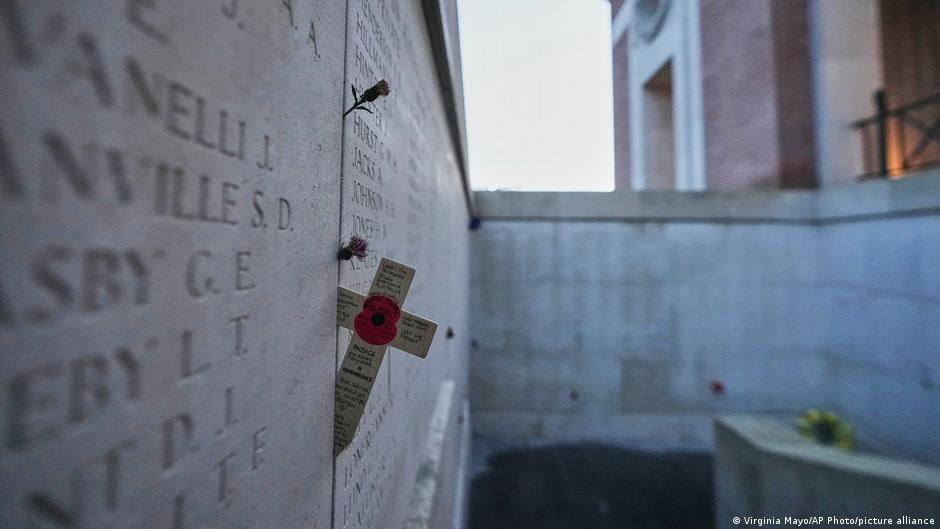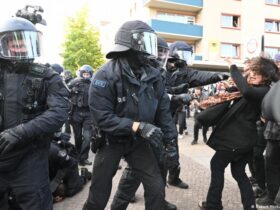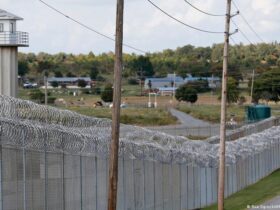Soldiers, veterans, politicians and spectators gathered in Ypres, western Belgium, on Tuesday to mark the 107th anniversary of the end of World War I in 1918.
He laid a wreath at the newly renovated Menin Gate memorial to those killed in Ypres, a Belgian city more or less at the center of the fighting during the Four Years’ War, which often featured commemorative poppies, which became synonymous with the conflict on the Western Front.
The halt in fighting until 11 am local time on 11 November is known as Armistice Day and is also commonly adopted by many countries as a day to honor veterans. – Whether as Veterans Day in the US or as Remembrance Day in France and Commonwealth member countries such as the UK, South Africa, Australia and New Zealand.
It is a public holiday in France, the US and Belgium, while the UK holds its major celebrations on the nearest Sunday each year, but with a two-minute silence at 11am on the 11th.
Celebrations in Europe and beyond
Soldiers and politicians laid wreaths at the Menin Gate of Ypres, bagpipes and bugles played as the ranks wrote down the structure the names of thousands of soldiers who had died but were left without graves because their remains had not been recovered.
A choir also sang John Lennon’s “Imagine” and a Belgian guitarist performed Bob Dylan’s scathing anti-war anthem “Masters of War.” Minister-President of Flanders Matthias Dependaele was the highest-ranking local politician in attendance. King Philippe of Belgium led the commemoration at the Tomb of the Unknown Soldier in Brussels in the south.
In Paris, French President Emmanuel Macron laid a wreath at the Tomb of the Unknown Soldier beneath the Arc de Triomphe, and lit the Eternal Flame at the monument, on which were engraved the words: “Here lies the tomb of a French soldier who died for the nation.”
Prime Minister Anthony Albanese attended a ceremony at the Australian War Memorial in Canberra, while the Sydney Opera House was lit with poppies and traffic was halted in key parts of the Melbourne central business district.
Albanese said, “We remember every young Australian refused the opportunity to grow old, and every Australian who came home but never completely gave up the fight.”
While King Charles and his heir William Prince of Wales were on the streets of London outside the Cenotaph for the main ceremonies on Sunday, Catherine of Wales, Princess of Wales, attended an Armistice Day event with veterans in Staffordshire on Tuesday.
Veterans Day was scheduled to be commemorated in the US later on Tuesday.
‘The war to end all wars’ resulting in modern destruction
Nearly 10 million soldiers died in the 1914–1918 war, which pitted the forces of France, the British Empire, Russia, and eventually the United States against a German-led coalition including the Austro-Hungarian and Ottoman empires, as well as Bulgaria. Hundreds of thousands of people died on the Ypres Salient alone.
Known at the time as the Great War or “the war to end all wars”, it was the first conflict on such a scale that introduced the more modern, industrial means of fighting that would come to define the conflicts of the 20th century until World War II and beyond.
Early iterations of tanks and aircraft hit the battlefield for the first time. Poisonous gas was used from both sides. Zeppelins flew over major cities such as London, causing no real damage but foreshadowing the widespread urban aerial bombardment of future wars. Aerial reconnaissance made artillery more accurate and destructive. And early automatic weapons such as machine guns faced old-fashioned infantry tactics with disastrous results for advancing troops.
Edited by: Dmytro Lyubenko






Leave a Reply